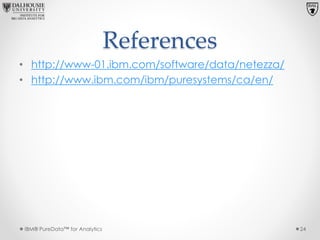

- #IBM NETEZZA SQL REFERENCE MANUAL#
- #IBM NETEZZA SQL REFERENCE 64 BITS#
- #IBM NETEZZA SQL REFERENCE SOFTWARE#
Now you can alter the child table and drop the constraint by its name using the following statement: What is Netezza used for The IBM Netezza appliance also includes a SQL dialect called Netezza Structured Query Language (NZSQL). SQL Server is the Microsoft-driven relational database management system. It has the same key design tenets of simplicity, speed, scalability and analytics power that was fundamental to Netezza appliances.
#IBM NETEZZA SQL REFERENCE MANUAL#
OBJECT_NAME (referenced_object_id ) = 'states' Access Free Ibm Netezza Manual Instead of using an actual IBM Netezza appliance, a virtualized environment was provided with a lab manual outlining the steps and commands to run. Part of the PureData family, the Netezza appliance is now known as the PureData System for Analytics. WHERE OBJECT_SCHEMA_NAME (referenced_object_id ) = 'dbo' AND OBJECT_SCHEMA_NAME (parent_object_id ) + '.' + OBJECT_NAME (parent_object_id ) AS 'Child Table' FROM sys. This IBM Redbooks publication explains how IBM Cognos Business Intelligence (BI) administrators, authors, modelers, and power users can use the dynamic query layer effectively.
#IBM NETEZZA SQL REFERENCE SOFTWARE#
Find foreign keys referencing to dbo.states table SELECT name AS 'Foreign Key Constraint Name' , SAS/ACCESS software who need specific information about Netezza. # Msg 3726, Level 16, State 1, Line 1 # Could not drop object 'states' because it is referenced by a FOREIGN KEY constraint.įor a given parent table, you can use the following query to get foreign key constraint names and the referencing table names:


Now if you try to remove the parent table states, the DROP TABLE statement fails: The -f option is also available for supplying a file. docker run -rm -it -env-filecdw.env dbhi/netezza nzodbcsql -q. Note that this only for testing since it returns a maximum of 100 rows for the query. Also note that if you are going to be doing this regularly, and if performance is an issue, you would probably want to change the where clause to filter on object IDs rather than text values.Assume there is a parent and child tables in SQL Server: To run a sample query, use the nzodbcsql command with the -q option to supply a query string. Note that this only works on data that has been loaded in the query history database, so depending on the activity and configuration of your system the results won't be real time. It has to do with the physical layout of the data across the spus and the fact it doesn’t chain rows like Oracle. I assume you are talking about adding a column and not adding a constraint to an existing column. JOIN histdb.HISTUSER."$hist_query_epilog_3" c Adding columns in Netezza does require recreating the table. JOIN histdb.HISTUSER."$hist_query_prolog_3" b netezza-sql-reference-manual 3/12 Netezza Sql Reference Manual have the possibility to combine your preferred tool for model generation (such as SAS Enterprise Miner or IBM SPSS® Modeler) with a different technology for model scoring (such as Zementis, a company focused on PMML scoring). SELECT FORMAT_TABLE_ACCESS(usage),įROM histdb.histuser."$hist_table_access_3" a Run Netezza SQL Script File using nzsql Variable Substitution. Create memory workpads by using the SPUPad This section describes the SPUPad feature, which allows UDX. All in all Netezza functions are not as rich as SQL Server. Netezza User Defined Functions Developer Guide system. In my case my history database is called HISTDB, and the history data is collected in the HISTUSER schema. The IBM Netezza system has four user priority levels for session query and execution. SQL is pretty similar, but Netezza may have different function to accomplish the same thing compared to SQL Server. Here's an example where we look for inserts, updates, deletes, and truncates on a given table. You can use this column in a where clause to filter for cases when the table was updated, and you can also use the FORMAT_TABLE_ACCESS() function to display the USAGE information in a human-readable format, as documented here.
#IBM NETEZZA SQL REFERENCE 64 BITS#
I want this identifier to have more than 64 bits of entropy, as the column may contain (in time) more than 1012 different records. The USAGE column in the $hist_table_access_ n table (where n is the version of the query history database you are using) contains information about what operations where performed against that table, as documented here. I'm working on IBM Netezza/PureData and I want to add an identifier column to a table containing billions of new records every day, so that I can track each record as it travels through different tables and systems.

However, you can mine this information from the query history database if you have turned on query history. Unfortunately the system does not record the last time that the contents of a table were modified in the catalog metadata.


 0 kommentar(er)
0 kommentar(er)
